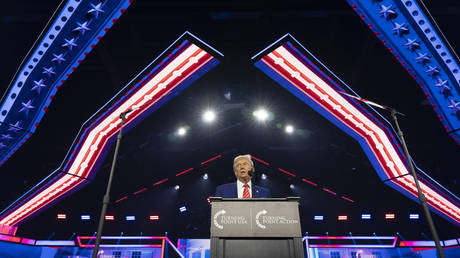Elon Musk envisages a future where anyone can have their own personal robot.
Tesla
Tesla plans to unleash a new generation of humanoid robots.Elon Musk revealed upgraded versions of Optimus at Tesla’s Robotaxi Day.Musk said they would be “the biggest product ever of any kind,” but it’s unclear how they will stand out from rivals.
Elon Musk has a long history of hype. Tesla’s Cybertruck, he has claimed, is “apocalypse-proof.” SpaceX’s Starship rocket, he has said, “will take humanity to Mars.” But his biggest hype claim yet may have only just arrived.
As Tesla held its long-awaited Robotaxi Day on Thursday at the Warner Bros. studio in Burbank, California, the billionaire introduced a new generation of the company’s humanoid robots, known as Optimus, with a bold prediction: they will be “the biggest product ever of any kind.”
Musk made his case by showing off technology that has come a long way since its initial reveal. Our first look in 2021 was an actor dancing in a body suit. In 2022, a first-look prototype appeared stiff walking onstage.
But prototypes on display this week looked smoother as they danced, poured drinks, and played rock-paper-scissors with attendees at Tesla’s event. Theatrics aside, Musk has made clear he means business with robots.
Tesla Optimus robot prototypes walk onto the stage with Elon Musk
Screengrab from We, Robot livestream
In July, Musk said Tesla would have “genuinely useful humanoid robots in low production for Tesla internal use next year” and high production for sale to other companies in 2026. If enough people are willing to pay the $20,000-$30,000 price tag Musk shared at Thursday’s event, he believes a future is coming where “the Optimus will walk among you.”
Musk’s plans to make humanoid robots mainstream face some tough challenges, however.
Optimus faces rivals and technical hurdles
Ambitions to build robots that look and act like humans — typically the reserve of science fiction stories — have generated fresh energy in recent years.
Tech leaders have increasingly explored developing their own versions of the technology, which has been touted to have potential applications across industries to help fill labor shortages and take on tasks that pose high risks to human safety.
In October 2023, Amazon boosted its partnership with Oregon State University spin-off Agility Robotics to bring its bipedal humanoid robots, known as Digit, into Amazon warehouses where they can “move, grasp, and handle items.”
Digit is designed to operate alongside human employees.
Amazon
AI chip giant Nvidia has also been looking to make robotics its next big arena of innovation. Billionaire CEO Jensen Huang talked up the technology at the company’s annual GTC event in March, announcing a foundation model involving robotics and AI called Project GR00T, meant to help the industry “take giant leaps” toward more advanced humanoid robots. Last month, Huang predicted a future with personal robots like R2-D2 and C-3PO from Star Wars, a comment echoed by Musk on Thursday.
Startups have been getting in on the action, too. Robotics startup Figure, founded in 2022 and now worth $2.6 billion, used Nvidia technology to develop the newest version of its humanoid robot, which it revealed in August. Meanwhile, in April, Hyundai-owned Boston Dynamics launched a new version of its robot named Atlas. It said the robot was “designed for real-world applications.”
Before these new iterations were revealed, industry watchers were already predicting explosive growth in the humanoid robotics market. A February report by Goldman Sachs suggested the total addressable market could hit $38 billion by 2035, up from its previous $6 billion projection.
It is unclear how Musk’s Optimus robots will stand out in this fast-growing market and become “the biggest product ever of any kind.”
Paul Miller, vice president and principal analyst at research firm Forrester, told Business Insider that while people love “geeking out” about robots that walk,” compelling use cases for them are less obvious.
“These robots have a wow factor, but they may not have the best form factor for addressing industry’s dull, dirty, and dangerous tasks,” he said. “We should all focus more on the task we’re trying to complete and less on how cool the robots look.”
Making further improvements to humanoid robots is a tough technical challenge. Earlier this year, Jim Fan, one of Nvidia’s top AI and robotics researchers, wrote on X that the “data recipe is way more complex for robotics than ChatGPT,” with advances in models underlying humanoid robots depending on a mix of “internet data, simulation data, and real robot data.”
Gene Munster of Deepwater Asset Management felt the Optimus project is “more advanced” than he expected, moving from “a prototype to the pilot phase,” but acknowledged that the units displayed on Thursday still felt more robot than human.
So, while Musk might have staked himself in a new technological battle taking shape in robotics, it seems he has some work to do if he’s serious about making Optimus bigger than anything he’s ever done.





+ There are no comments
Add yours